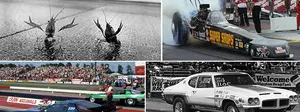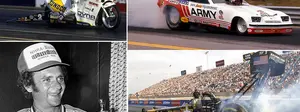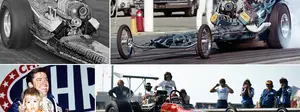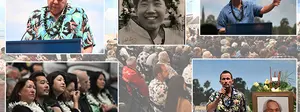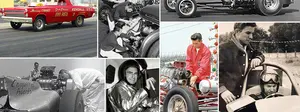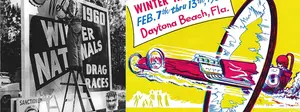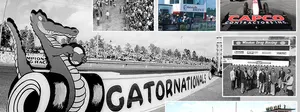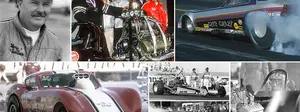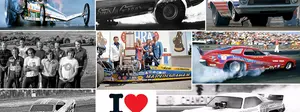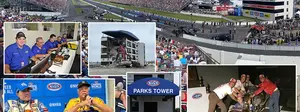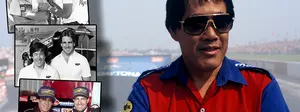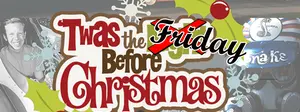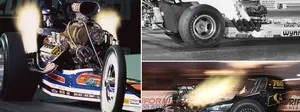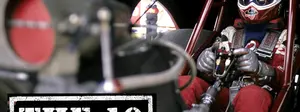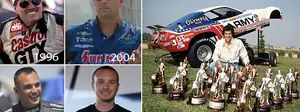The Photo Hoarder, Part 2
After a two-week side trip down the memory lane of Raymond Beadle’s life, let’s return to our previous thread on photo hoarding. As noted previously, I believe that it’s a widespread practice among drag racing fans –- yours truly included -– while browsing the Internet. If they spy a particularly fetching photo, they can simply right-click on it and save it to their hard drive for their viewing or sharing pleasure. I showed off a few from my relatively small collection in that first column.
 Alan Earman shot this famous photo of Tom McEwen for a DRUSA story. |
I also noted that I’m pretty fervent in seeing that photographers get credited for their work, even if it has been pilfered from the Web. Unfortunately, none of the photos I posted have had their creators identified, but I’m hopeful that they, and those in my second batch below, will be duly credited.
Between that column and this, I was proud to hear from Alan Earman, another of the small but talented group of 1960s-70s photographers whose work populated those great early drag racing magazines. Being one of those whose works do get re-used beyond the original copyright, I was interested in his take.
“In the early days of drag racing, a photographer would receive photo credit as payment for the pictures and a press pass that would get you entry to a track, and the recognition the photographer got when their photos were published with a photo credit meant something to them,” he wrote. “They became part of the drag racing fraternity. And to a great many of them, that was more important than the little monetary compensation they got if you were lucky enough to get paid. I find it very sad that most of the older photos I see online today, there is no mention of the photographer. I'm happy however to know that the interest is still there for the older photos.” Amen, brother.
And with that, on to Part 2 of Phil’s Treasures.
 |
Believe it or not, I had this photo tabbed to be included before we lost Beadle because it’s a pretty rare item. OK, let’s overlook for a second that this Funny Car is doing a burnout in the staging lanes at Orange County Int’l Raceway and focus on the machine itself. Yes, race fans, this is the Blue Max before car owner Harry Schmidt christened it as such. In its earliest incarnation in 1969, the car (driven by Paul Gordon and Jake Johnston) was lettered just with Schmidt’s name. It wasn’t until later that year, when Schmidt saw the movie Blue Max and fell in love with the emblem, that the car got its name.
 | This one tugs at my heartstrings. Two of our dearly departed heroes, Pat Foster, right, and Gordie Bonin, were officially welcomed into the Cragar Five-Second Club as its third and fourth members during the 1979 World Finals at Ontario Motor Speedway. Foster cracked into the fives April 8 of that year in Fremont with a 5.98 in the Super Shops Arrow, and Bonin joined him after a 5.97 at that year’s U.S. Nationals in his memorable Bubble Up Firebird. For a complete listing of the clubs (and all other NHRA Performance Clubs), click here. |
 |
Even the best of drivers lose the handle from time to time. Here’s Brad Anderson chasing the starting-line staff at Fremont Raceway in what I’d guess would be about 1973. I saw Anderson a ton during my many years at OCIR but only saw him crash once, later in 1983. The car got loose off the starting line and hit and then climbed over the guardrail. Anderson couldn’t repair the car in time for the Finals (also at OCIR that year), so he borrowed Mike Grieco’s similar car and won the race. (Gary Aronson photo)
 |
As I said before, the photos that I hoard are the ones that strike a chord in me, and this one does. It’s the crew of Lew Arrington’s Brutus, their evening done for whatever reason, perched atop their ramp truck to watch the rest of racing. Love the period clothing, too. Sweet photo.
 |
I’m a sucker for one-off Funny Car bodies, and Sheldon Konblett, founder of the Service Center line of hot rod shops, is one of my heroes for that. After fielding a Lawdawri kit-car-bodied car called Chicken Little, Konblett introduced his successful Ford LTD flopper (dubbed Peanuts) in 1966, which he followed with this wild 1961 Jaguar XKE that he called Snoopy. I talked to Konblett’s son, Greg, earlier this week, who shared info about his dad and the cars. (Sheldon died in a boating accident in 1986.) The names for the final two cars were inspired not just by Konblett’s love of the Peanuts comic strip, but also because they ran in what was commonly called “the funny pages” -- funny pages, Funny Car. By all accounts, Peanuts was an ill-handling car, with some blame attributed to the body itself and possible loads it put on the tires. The car, which was featured on the cover of the November 1967 issue of Car Craft under the blurb “Snoopy’s Laughing Jag,” got so scary that Konblett’s wife forbade him to drive the car. Johnny Hoffman, a 26-year-old driver from Norwalk, Calif., took over the controls, and on his maiden pass on March 30, 1968, the car went out of control at more than 170 mph at Lions Drag Strip and rolled six times. Hoffman was killed, and Konblett, grief-stricken by the accident, retired from serious racing. Pretty sure this photo was taken by the late, great Bob "Plum" Plumer.
 |
Here’s another oddball Funny Car, Texan Ray Capps’ Head Hunter Dodge Charger, circa 1967. It’s hard to believe that he could see through the windscreen with the top so severely chopped, but this photo just invokes for me that “Well, we’ll never know until we try it” methodology of the sport’s pioneers.
 |
Gotta love this pic of the late, great Jack Chrisman blasting off the line in his GT-1 Mercury Comet, circa 1967, with the exhaust blasting under the car in the days before zoomie headers. The car stunned the Funny Car crowd at the 1967 Nationals with a 7.60 blast; no other car ran in the sevens.
 |
I remember first seeing this stunning pic in one of those wonderful Drag Racing Photo Greats magazines that Mike Doherty used to publish and had forgotten all about it until I came across this copy of it online a while ago. The first good news is that, thanks to that old magazine (which I still have, of course), I can tell you that the photographer was Marty Lemmermann and that the driver was Gerry Studnicka, who actually got away with relatively minor injuries. And, thanks to my good pal and jet-car pioneer Roger Gustin, I can tell you exactly what went wrong with this jet-powered, Romeo Palamides-owned AMC Javelin. According to Gustin, the event was the annual Labor Day race at Great Lakes Dragaway in 1972, and thankfully for him, Gustin turned down a chance to drive the car because he had his own car, the Time Machine jet Funny Car (his first jet car).
“This was two years before I got the jets approved by NHRA,” he reported, “and at that time, there were no rules or safety standards or tech inspections for jets. (It will be 40 years, on Nov. 10, since NHRA approved the jet-car program, and I received the first license to race jet cars). I was on the return road and watched this horrible scene.”
Gustin said that a number of factors, including rotted fuel lines and the use of a J-34-36 Westinghouse engine – the only jet engine ever built to use gasoline rather than J-P4 kerosene or diesel fuel – were to blame. “All the other jet cars with this type of engine had a gas-start system, and as soon as the engine started, they would switch to kerosene because gas is much more flammable than kerosene,” he remembered. “Romeo chose to use gas only for fuel, and the main fuel line split at high PSI, which sprayed fuel into the driver area. [Because there were] NO rules, there were no fire bottles. Note also that Gerry had no gloves or face shield. His only injuries were his hands and face; the heat boiled the master cylinder, so he had no brakes, but the car stopped on its own. He was a very lucky guy. Romeo did destroy this car, and it never ran again.''
 |
If you’ve been around for a while, you’ve probably seen the famous photo of wheelstander king “Wild Bill” Shrewsberry standing up through the windshield of his L.A. Dart in mid-wheelie at Fremont, but I bet you’ve never seen this one of “Wild Bill” doing the same at Orange County while a passenger in Gary Watson’s Paddy Wagon, which is probably where he got the idea. I emailed Watson to find out how the heck this magic moment came about. “It was at the end of an eight-car show, and the track had all eight at the starting line for fans to vote on best show,” he remembered of the run, which was in November 1967. “They asked us all to return to the pits, and ‘Wild Bill’ jumped in and rode to finish line up in the air.” And you wonder why they called him “Wild Bill.” (Here’s the answer.)
 |
I’ve loved Jim Dunn since the first time I saw Funny Car Summer, and his rear-engine Barracuda was not only the most successful of the breed, but also a lot of fun to watch, as this photo from Lions Drag Strip attests.
 |
Speaking of rear-engine Funny Cars, here’s a pretty interesting shot of Gary Gabelich’s ill-fated, four-wheel-drive, rear-engine car minus its Vega panel wagon body. That’s Cragar President Roy Richter trying out the cockpit with Gabelich showing him the controls. I wrote about this car here a few years ago during the rear-engine Funny Car thread.
 |
And speaking of four-wheel-drive cars, here’s a wonderful shot of Tommy Ivo’s four-engine, all-wheel-drive Showboat. It’s the only color action shot I’ve ever seen of the car, but Ivo tells me there are others, but, this, too, is one of his favorites. What’s clear through all the smoke is that it’s Ivo’s car and that the photo was taken at Lions Drag Strip (check out Lions manager C.J. “Pappy” Hart, right, and starter Larry Sutton watching in the background). What’s not clear is who was driving. Ivo and Ron Pellegrini disagree. Ivo tells me that it’s Tom McCourry (who replaced Don Prudhomme after the pre-“Snake’s” short stint in the car), and Pellegrini swears that the helmet is too high in the cage to be Prudhomme and thinks that it’s himself in the car.
 |
Pete Everett was the man behind the popular Pete’s Lil Demon Funny Cars of the early 1970s, driven by Leroy “Doc” Hales, Bob Pickett, and a few others. Everett also owned a Southern California Chevron gas station, which explains this great photo. It's from Hales’ driving era, but, according to the good doctor, whom I reached by email earlier this week, that’s not him climbing out of the car but Everett’s son, Bill. Hales was unable to attend the photo shoot because he was in medical school classes at the time. You can read a whole lot more about Hales in the column I wrote a few years ago (Leroy 'Doc' Hales: World's fastest doctor).
“Pete Everett and I had a GREAT relationship,” he went on to tell me. “I grew up without a father, and from the age of about 16, when I began working at Pete's Chevron gas station, we developed a relationship that was somewhere between a father and big brother. Pete was the best man at my wedding in 1974. We had a great time racing on a modest budget but didn't travel much, mostly because I was in college at USC, then medical school at UC Irvine. Pete and I did almost all the engine work, except for machining, with tuning help from Gary Smith (Ansen wheels and Arias pistons). Pete had a great work ethic and loved the adulation of fans and the companionship of fellow racers. We held our own as relatively low-budget weekend Funny Car racers. Those were some of the best times of our lives for both of us. The last time I actually saw Pete was when I took him to the Bakersfield Hot Rod Reunion in 1997. We stayed in touch until he died from complications of Alzheimer's disease about five to six years ago.”
 |
Gee, I can’t think of a single reason why Don Kohler called his Top Fueler the Defiant One, can you? Wayne Farr built this shorty car, which was fitted with a ’23-T body. The car was later lengthened and fitted with a more conventional body.
 |
To say that the early Pisano Bros. Funny Cars were cursed would be like saying that the sky was usually blue over Orange County Int’l Raceway. After a safe 1968 with the ex-Doug Thorley Corvair, brother Frankie Pisano wiped out their new Corvair in an on-track tangle with Randy Walls at Irwindale Raceway in early 1968. Then, later that year, as pictured here, Sush Matsubara (in what I understand was his first drive for Papa Joe) lost the handle and backed Joe P’s third Corvair into the top-end guardrail at OCIR. Matsubara then stacked up Pisano’s Camaro at the 1970 Supernationals at Ontario Motor Speedway after breaking the rear end. In 1971, a big fire at the Fremont Raceway PDA event claimed the next Camaro. The car was so cursed that Drag Racing USA devoted a whole story to the travails in the November 1971 issue.
 |
Lil' John Lombardo was known as one of Southern California’s most consistent and hard-running Funny Car racers, but his choice in paint schemes sometimes left something to be desired.
 |
In addition to being one of the best Top Fuel racers of the 1970s, ol’ “Big Daddy” Don Garlits was also a bit of a pyro. Fire burnouts were a frequent part of Garlits’ match race show. Another photo by Plum I believe.
 |
Give Steve Reyes due credit for this photo of “the world’s fastest hippie,” Mike Mitchell, lighting up his 'Cuda at Irwindale Raceway. This photo, one in the great line of Pop Rod Show Stopper images that appeared in each issue of Popular Hot Rodding magazine in the 1970s, brings back nostalgic memories to me, as I practically wallpapered my bedroom with them.
OK, that’s it for today. I have a few more in my “collection” that maybe I’ll share someday. I’ll also offer up the chance for some of you to share your hoarded collections in the future; send your 10 favorite pics to me at pburgess@nhra.com, and I’ll publish the best. See you next Friday.















